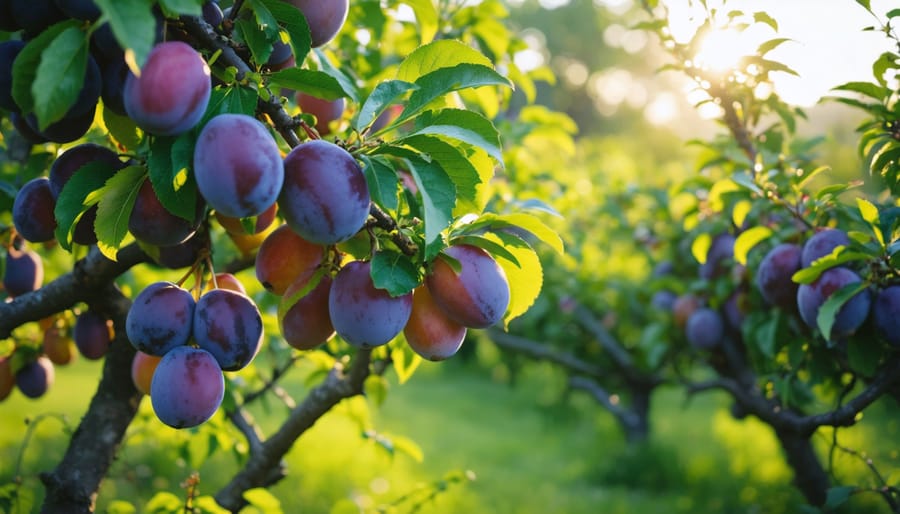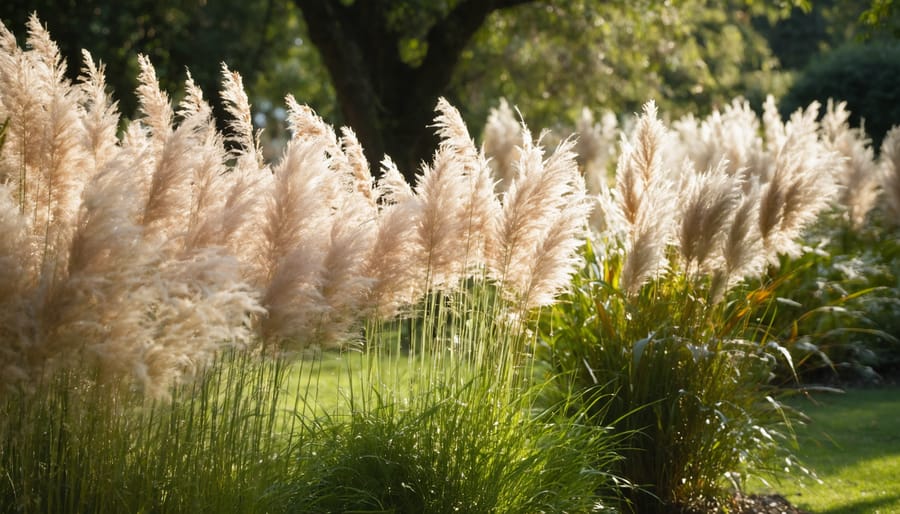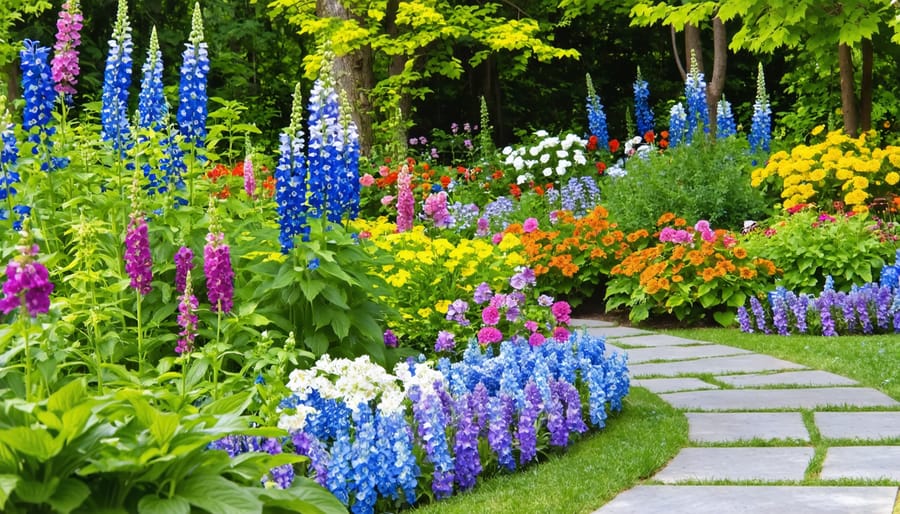Transform your shaded garden spaces into thriving oases by mastering essential shade gardening techniques. Select shade-loving plants suited to your specific light conditions, whether it’s dappled shade beneath deciduous trees or deep shade along north-facing walls. Prepare rich, well-draining soil enhanced with organic matter to compensate for reduced photosynthesis in low-light conditions. Create layers of visual interest by combining tall shade-tolerant shrubs with mid-height perennials and ground covers, ensuring each plant receives its optimal share of available light. Monitor soil moisture carefully, as shade gardens often retain water longer than sunny spots, while still requiring consistent irrigation during dry spells. With proper plant selection and care techniques, shaded areas become perfect sanctuaries for lush, vibrant gardens that flourish even without direct sunlight.
Understanding Different Types of Shade

Full Shade vs. Partial Shade
Understanding the difference between full shade and partial shade is crucial for successful shade gardening. Full shade typically means an area that receives less than 2 hours of direct sunlight daily or only filtered light through dense tree canopies. These spots are perfect for shade-loving plants like hostas and ferns.
Partial shade, on the other hand, offers 2-6 hours of direct sunlight, usually during morning or late afternoon hours. This environment supports a wider variety of plants, including begonias, impatiens, and some varieties of hydrangeas. The quality of light also matters – morning sun is generally gentler than afternoon sun.
A helpful tip for determining your garden’s shade level is to observe the area throughout the day. Take note of how long direct sunlight hits different spots and at what times. You might be surprised to find that what you thought was full shade actually receives pockets of light during certain hours.
Remember that shade patterns can change seasonally, especially in gardens with deciduous trees. Areas that are fully shaded in summer might receive more light in winter when trees lose their leaves.
Measuring Your Garden’s Light Levels
Understanding your garden’s light levels is essential for successful shade gardening. The simplest way to measure light is to observe your garden throughout the day, noting how sunlight moves across different areas. Start by checking your garden at three key times: morning (around 8 AM), midday (noon), and afternoon (4 PM).
Take photos or make sketches of shaded areas at these times, marking where shadows fall. You can also use the hand shadow test: if you can see a crisp shadow, that area receives direct sun; a fuzzy shadow indicates partial shade; no shadow means full shade.
For more precise measurements, consider using a light meter, which provides exact readings of light intensity. However, don’t feel pressured to buy special equipment – many experienced gardeners rely solely on observation and note-taking.
Remember that light patterns change with the seasons. What’s shady in summer might receive more light in winter when trees are bare. Keep a simple garden journal to track these changes, making notes about which areas receive how much light during different seasons. This information will prove invaluable when choosing and placing your shade-loving plants.
Preparing Your Shade Garden Soil
Soil Amendment Tips
Shaded areas often present unique challenges when it comes to soil management techniques, but with the right amendments, you can create an optimal growing environment for your shade-loving plants. Start by conducting a simple soil test to determine your soil’s pH and nutrient levels, as shaded areas tend to be more acidic due to decomposing leaf matter.
To improve soil structure, incorporate plenty of organic matter such as well-rotted compost, leaf mold, or aged manure. These materials not only enhance drainage but also provide essential nutrients that shade plants need to thrive. Working in 2-3 inches of compost annually will help maintain soil health and encourage beneficial microorganisms.
Pay special attention to drainage in shaded areas, as they typically retain moisture longer than sunny spots. If your soil is heavy clay, add coarse sand or fine gravel along with organic matter to improve drainage. For sandy soils, focus on adding more organic material to increase water retention.
Remember to mulch your shade garden with a 2-inch layer of shredded leaves, pine needles, or bark chips. This helps retain moisture, suppress weeds, and gradually improves soil quality as it breaks down over time.

Drainage Solutions
Proper drainage is crucial in shaded gardens, as these areas typically retain more moisture than sunny spots. While this might seem beneficial, excessive water retention can lead to root rot and fungal problems. Start by testing your soil’s drainage by digging a hole about 12 inches deep, filling it with water, and observing how quickly it drains. If water sits for more than a few hours, you’ll need to improve drainage.
To enhance drainage in shaded areas, mix organic matter like compost or leaf mold into your soil. This not only improves water flow but also adds valuable nutrients. Consider raising your planting beds by 6-8 inches, which naturally improves drainage and gives roots more room to grow. Adding a layer of gravel beneath your soil can also help excess water move away from plant roots.
For container gardens in shaded areas, ensure pots have adequate drainage holes and use well-draining potting mix. Place containers on feet or bricks to allow water to flow freely. Remember to mulch your garden beds with materials like pine straw or bark chips, keeping the mulch a few inches away from plant stems to prevent moisture-related issues.
Planting Techniques for Shade Success
Proper Spacing and Depth
Proper spacing is crucial for a thriving shade garden, as plants need room to grow without competing too intensely for limited resources. When planning your garden, consider the mature size of each plant rather than their current dimensions. Popular shade-loving plants like hostas in shade gardens can spread significantly, so give them plenty of room to expand.
For most shade-loving perennials, follow the general rule of spacing plants at distances equal to their expected mature width. Small woodland flowers might need only 6-12 inches between plants, while larger specimens like ferns may require 2-3 feet of space. Remember that plants in shade often grow more slowly than their sun-loving counterparts, so resist the urge to plant too closely for immediate impact.
Planting depth is equally important. Most shade plants prefer well-draining soil and should be planted at the same depth they were growing in their nursery containers. When transplanting, dig holes twice as wide as the root ball but only as deep as the plant’s original growing depth. This allows roots to spread easily while preventing water from collecting around the crown, which could lead to rot.
For layered interest, consider creating tiers with taller plants like Japanese maples in the background, medium-height perennials in the middle, and ground covers in the front. This approach not only creates visual appeal but also maximizes available light for smaller plants.
Seasonal Planting Tips
Spring and fall are the prime seasons for establishing shade gardens, as these periods offer optimal growing conditions and reduced stress on new plants. Early spring, just as the soil becomes workable, is perfect for planting most shade-loving perennials before the tree canopy fully develops. This timing allows plants to establish strong root systems while benefiting from increased light exposure.
Fall planting, particularly from late August through October, provides similar advantages. The cooling temperatures and increased rainfall create ideal conditions for root development, while the still-warm soil encourages growth. Plus, falling leaves contribute natural mulch and organic matter to your garden bed.
When planting in summer, choose early morning or late afternoon to avoid the day’s heat. Water newly planted specimens thoroughly and provide extra attention to moisture levels during the first few weeks. Winter planting is possible in mild climates but requires careful attention to soil temperature and frost protection.
Regardless of the season, prepare your planting area by incorporating organic matter into the soil and ensuring proper drainage. Space plants according to their mature size, considering that shade-tolerant plants often grow more slowly than their sun-loving counterparts. Apply a 2-3 inch layer of mulch after planting, keeping it away from plant stems to prevent rot.
For container gardens in shaded areas, spring and early summer plantings typically yield the best results, allowing plants to establish before the challenging winter months.
Maintenance and Care

Watering Strategies
Watering shade gardens requires a thoughtful approach, as these areas often retain moisture longer than sunny spots. While shade-loving plants typically need less water than their sun-loving counterparts, they still require consistent moisture to thrive.
The key is to water deeply but less frequently, encouraging roots to grow deeper into the soil. Check the soil moisture by inserting your finger about 2 inches deep – if it feels dry at this depth, it’s time to water. Most shade gardens benefit from watering early in the morning, allowing plants to absorb moisture before the day begins.
Consider using a soaker hose or drip irrigation system to deliver water directly to the root zone. This method is particularly effective in shade gardens as it helps prevent fungal issues that can develop when foliage remains wet. If using a regular hose, always water at the base of plants rather than spraying from above.
During particularly dry spells, apply a 2-3 inch layer of organic mulch to help retain moisture. This not only reduces watering frequency but also adds nutrients to the soil as it breaks down. Be careful not to let mulch touch plant stems, as this can lead to rot.
Remember that different shade plants have varying water needs. Ferns and hostas typically prefer consistently moist soil, while established woodland plants might tolerate drier conditions. Adjust your watering schedule based on weather conditions and individual plant requirements.
Pruning and Dividing
Regular pruning and dividing are essential tasks for maintaining healthy shade garden plants. Most shade-loving perennials benefit from yearly maintenance to prevent overcrowding and encourage robust growth. The best time for these tasks is typically early spring or fall when temperatures are mild and plants are either emerging or preparing for dormancy.
For pruning, start by removing any dead, diseased, or damaged foliage using clean, sharp gardening shears. This not only improves appearance but also prevents potential disease spread. With flowering plants like hostas and astilbe, cut back spent blooms to redirect energy to the roots and foliage. Remember to trim back any leggy growth that might be reaching too far for light, as this helps maintain the plant’s natural shape.
Division is particularly important for spreading perennials that form dense clumps. Plants like ferns, hostas, and hellebores should be divided every 3-4 years to prevent overcrowding and maintain vigor. Wait for a cloudy day to minimize plant stress, then carefully dig up the entire plant and separate it into smaller sections, ensuring each division has healthy roots. Replant immediately at the same depth as before, water thoroughly, and add a layer of mulch to retain moisture.
Don’t forget to clean your tools between plants to prevent disease transmission, and always dispose of diseased plant material in the trash rather than your compost pile. With regular maintenance, your shade garden will remain vibrant and healthy throughout the growing season.
Troubleshooting Common Issues
Pest Management
Shade gardens may experience fewer pest problems than sunny areas, but they still require vigilant monitoring for common garden pests and diseases. Slugs and snails are particularly fond of shaded, moist environments, so consider placing copper tape around vulnerable plants or using organic slug pellets. Coffee grounds scattered around plants can also deter these slimy visitors while enriching your soil.
Japanese beetles and vine weevils can be problematic in shade gardens, especially among hostas and ferns. Hand-picking these pests during morning hours when they’re less active can help control their population. For a natural solution, encourage beneficial insects like ground beetles and parasitic wasps by adding diverse native plants to your garden.
Root rot can develop in overly damp conditions common to shade gardens. Prevention is key – ensure proper drainage and avoid overwatering. If you notice yellowing leaves or stunted growth, check the soil moisture and adjust watering accordingly. A layer of well-draining mulch can help maintain ideal moisture levels while deterring soil-dwelling pests.
Remember to inspect your plants regularly and address any issues promptly. Healthy plants naturally resist pests better, so maintaining proper growing conditions is your best defense.
Disease Prevention
Preventing diseases in shade gardens starts with good air circulation and proper spacing between plants. While shade can create humid conditions that fungi love, there are several effective strategies to keep your plants healthy. Always remove fallen leaves and debris promptly, as these can harbor disease-causing organisms. When watering, focus on the soil rather than the foliage, and water early in the day so leaves can dry before evening.
Common shade garden diseases include powdery mildew, leaf spot, and root rot. To prevent these, ensure proper soil drainage and avoid overcrowding your plants. Adding a layer of mulch helps maintain consistent soil moisture while keeping soil-borne pathogens at bay. If you notice signs of disease, remove affected leaves immediately and dispose of them in sealed bags, not your compost pile.
Consider using disease-resistant plant varieties when possible, and rotate annual plants yearly to prevent pathogen buildup in the soil. A balanced fertilization program helps plants maintain natural disease resistance, but avoid over-fertilizing, which can lead to weak, disease-prone growth. Regular inspections of your shade garden allow you to catch and address potential problems before they become severe.
Creating a thriving shade garden is an exciting and rewarding journey that opens up endless possibilities for your outdoor space. By understanding the different types of shade, selecting appropriate plants, and implementing proper care techniques, you can transform even the darkest corners of your garden into vibrant, lush retreats. Remember that success comes from careful planning, regular maintenance, and patience as your plants establish themselves. Don’t be afraid to experiment with different combinations of shade-loving plants, and celebrate the unique beauty that these resilient species bring to your garden. Whether you’re working with dappled shade under trees or deep shade along a north-facing wall, there’s a perfect plant waiting to flourish in your space. Start small, learn from experience, and watch as your shade garden becomes a peaceful sanctuary that proves darkness needn’t limit your gardening dreams.




